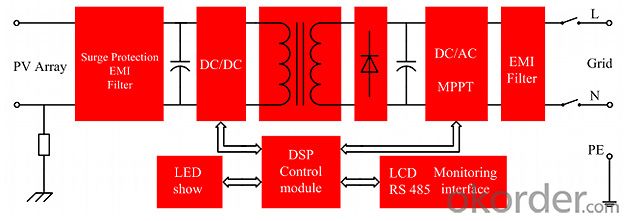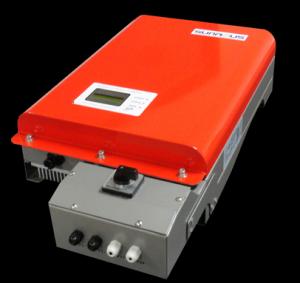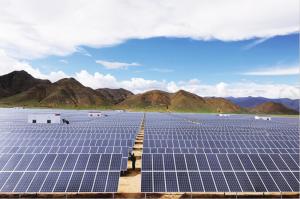High Frequency Transformer Isolation PV Grid-Tied Inverter
- Loading Port:
- Shanghai
- Payment Terms:
- TT or LC
- Min Order Qty:
- 20 pc
- Supply Capability:
- 1000 pc/month
OKorder Service Pledge
OKorder Financial Service
You Might Also Like
High Frequency Transformer Isolation PV Grid-Tied Inverter
LF series 0.6kw — 1.5kw
Features: Single stage inverter is the main characteristic of this product , in which power grade period compared with other topological structure has higher conversion effciency and reliability
characteristics:
5 years warranty
· Sealing stainless steel shell, suitable for indoor or outdoor installation
· High frequency transformer isolation
· The highest effciency achieves 98%
· Wide input Voltage range
· Adopt connectors type cable connection, Easy operation and installation
· Best tracking effciency with OptiTrac MPP control
· operating temperature range -25 ℃ to + 55℃
· High reliability due to complete protection function
· Anti-theft protection
· Plug-in grounding
HF series 1.5kw — 5.0kw

High frequency transformer isolation is the main feature of our production, which make Installation easier due to the reduced weight and higher conversion effciency because of omitting Low frequency transformer. The wide input voltage range from 180 to 600volt gives you extraordinary fexibility for you system design. Not need to set graphic display and RS485 communication system make the devices highly user-friendly.
This product can by multi-level parallel combination for 6kw to 20kw needed any power grade HF series technical parameter.
parameters:
GT1.5-ZX-01/HF | GT2.0-ZX-01/HF | GT2.5-ZX-01/HF | GT3.0-ZX-01/HF | GT4.0-ZX-01/HF | GT5.0-ZX-01/HF | |
Input(DC) | ||||||
Max.DC Power | 1600W | 2100W | 2650W | 3150W | 4200W | 5200W |
Max.DC Voltage | 600V | |||||
PV Voltage range, MPPT | 150V ~ 550V | 150V ~ 550V | ||||
Max.input current | 10.0A | 14.0A | 16.0A | 20.0A | 25.0A | 30.0A |
Number of MPP trackers | 1 | |||||
Max.number of strings (parallel) | 1 | 1 | 2 | 2 | 3 | 3 |
Output(AC) | ||||||
Nominal AC power / | 1500W | 2000W | 2500W | 3000W | 4000W | 5000W |
Max.output current | 13.0A/7.0A | 17.0A/9.0A | 21.0A/12.0A | 25.0A/14.0A | 21.0A | 30.0A |
Nominal AC Voltage / range | 102-138Vac/180-264Vac | 180-270Vac | ||||
AC grid frequency / range | 47.5-51.5Hz / 59.3-60.5Hz | |||||
Power factor at rated power | 1 | |||||
THD | < 3% | |||||
AC connection | Single-phase | |||||
Efficiency | ||||||
Max. efficiency/Californian efficiency | > 98.0% / > 97.0% | |||||
MPP adaptation efficiency | > 99.0% | |||||
Protection devices | ||||||
DC reverse polarity protection | √ | |||||
AC short-circuit protection | √ | |||||
Ground fault monitoring | √ | |||||
Grid monitoring | √ | |||||
Output Transient Voltage Suppression | √ | |||||
Over load | √ | |||||
Anti-islanding | √ | |||||
General data | ||||||
Dimensions (W/ H / D) in mm | 350 / 560 / 160 | 370 / 540 / 185 | ||||
Weight(Kg) | 16 | 19 | 23 | |||
Operating temperature range | -25 ~ +60℃ | |||||
Storage temperature range | -40 ~ +70℃ | |||||
Ambient humidity | 0 ~ 100% | |||||
Consumption (night) | < 0.5W | |||||
Topology | HF-transformer galvanic isolation | |||||
Cooling concept | Convection | |||||
Enclosure type | IP65 / NEMA 3R | |||||
Features | ||||||
DC connection: PV special connector | √ | |||||
AC connection: connector | √ | |||||
LCD display & Backlit | √ | |||||
LED display | √ | |||||
Interfaces: RS485 | √ | |||||
Warranty: 10 years | √ | |||||
Certificates & approvals | G83 / G59 / TUV / SAA / ETL / JET/ CE | |||||

- Q:How does a solar inverter handle variations in ambient temperature?
- A solar inverter handles variations in ambient temperature by incorporating temperature compensation mechanisms. These mechanisms allow the inverter to adjust its operation and optimize performance based on the temperature conditions. By monitoring the temperature, the inverter can regulate voltage levels, adjust power outputs, and protect itself from overheating. This ensures that the inverter operates efficiently and reliably under different ambient temperature conditions.
- Q:How does the voltage regulation affect the performance of a solar inverter?
- Voltage regulation plays a crucial role in the performance of a solar inverter. It ensures that the output voltage of the inverter remains stable and within an acceptable range, regardless of fluctuations in the input voltage. This stability is vital for the efficient operation of the inverter and the overall performance of the solar power system. Improper voltage regulation can lead to various issues such as increased power losses, reduced energy production, and potential damage to connected devices.
- Q:How does a solar inverter handle voltage dip and interruption?
- A solar inverter handles voltage dip and interruption by monitoring the grid voltage constantly. When it detects a dip in voltage or an interruption, it quickly switches to an internal power source, such as a battery or capacitors, to keep supplying power to the connected solar panels or loads. This ensures a smooth and uninterrupted power supply even during voltage fluctuations or grid outages.
- Q:How does the input voltage rating affect the performance of a solar inverter?
- The input voltage rating is a critical factor in determining the performance of a solar inverter. The inverter's ability to convert the direct current (DC) generated by solar panels into alternating current (AC) for use in homes or businesses depends on the input voltage rating. If the input voltage rating of the inverter is not compatible with the voltage produced by the solar panels, the inverter may not function properly or may even be damaged. Thus, selecting an inverter with the correct input voltage rating is essential for optimal performance and longevity of a solar power system.
- Q:Can a solar inverter be used with dual-axis solar trackers?
- Yes, a solar inverter can be used with dual-axis solar trackers. The dual-axis solar trackers continuously adjust the position of the solar panels to optimize sun exposure throughout the day. The solar inverter is responsible for converting the DC power generated by the solar panels into AC power for use in residential or commercial applications. Therefore, the solar inverter can be easily integrated with dual-axis solar trackers to ensure efficient power generation and utilization.
- Q:How does a solar inverter handle grid faults and disturbances?
- A solar inverter is equipped with various protective features to handle grid faults and disturbances. It continuously monitors the grid voltage and frequency, and in the event of a fault or disturbance, it reacts quickly to ensure the safety of the system and prevent any damage. The inverter's built-in protection mechanisms, such as overvoltage and overcurrent protection, allow it to disconnect from the grid when necessary. This protects the inverter and the solar panels from potential harm caused by grid faults. Additionally, some advanced solar inverters offer features like anti-islanding protection, which prevent the inverter from feeding power into the grid during a fault or disturbance, further ensuring the stability and reliability of the system.
- Q:Can a solar inverter be used in systems with different module capacities?
- Yes, a solar inverter can be used in systems with different module capacities. Solar inverters are designed to convert the DC power generated by solar modules into AC power for use in homes or businesses. They are typically flexible and compatible with a wide range of module capacities, allowing them to be used in systems with varying sizes and configurations. However, it is important to ensure that the inverter's capacity matches or exceeds the total capacity of the connected solar modules to ensure optimal performance and efficiency.
- Q:Are there any fire safety concerns associated with solar inverters?
- Yes, there are some fire safety concerns associated with solar inverters. While solar inverters are generally safe and undergo rigorous testing to meet safety standards, there have been rare instances of fires caused by faulty inverters or improper installation. It is crucial to ensure that inverters are installed by qualified professionals following manufacturer guidelines and regularly inspected for any signs of damage or malfunction. Additionally, proper maintenance and monitoring of the inverter system can help mitigate any potential fire risks.
- Q:What is the typical installation process for a solar inverter?
- The typical installation process for a solar inverter involves several steps. First, a suitable location for the inverter is identified, usually near the solar panels. The inverter is then mounted securely on a wall or other structure. Next, the DC wiring from the solar panels is connected to the input terminals of the inverter, ensuring proper polarity. The AC output terminals of the inverter are then connected to the electrical panel of the building, often through a dedicated circuit breaker. Finally, the inverter is connected to the monitoring system to track its performance and ensure optimal energy production. It is important to follow the manufacturer's instructions and consult a professional electrician to ensure a safe and efficient installation.
- Q:Can a solar inverter be used in regions with extreme weather conditions?
- Yes, a solar inverter can be used in regions with extreme weather conditions. However, it is important to choose an inverter that is designed and rated for the specific weather conditions of that region. For example, there are solar inverters available that are built to withstand high temperatures, extreme cold, humidity, and even harsh weather events such as hurricanes. It is crucial to consider the environmental factors and select an inverter that is suitable for the specific climate conditions to ensure optimal performance and longevity.
1. Manufacturer Overview |
|
|---|---|
| Location | |
| Year Established | |
| Annual Output Value | |
| Main Markets | |
| Company Certifications | |
2. Manufacturer Certificates |
|
|---|---|
| a) Certification Name | |
| Range | |
| Reference | |
| Validity Period | |
3. Manufacturer Capability |
|
|---|---|
| a)Trade Capacity | |
| Nearest Port | |
| Export Percentage | |
| No.of Employees in Trade Department | |
| Language Spoken: | |
| b)Factory Information | |
| Factory Size: | |
| No. of Production Lines | |
| Contract Manufacturing | |
| Product Price Range | |
Send your message to us
High Frequency Transformer Isolation PV Grid-Tied Inverter
- Loading Port:
- Shanghai
- Payment Terms:
- TT or LC
- Min Order Qty:
- 20 pc
- Supply Capability:
- 1000 pc/month
OKorder Service Pledge
OKorder Financial Service
Similar products
New products
Hot products
Hot Searches
Related keywords





























